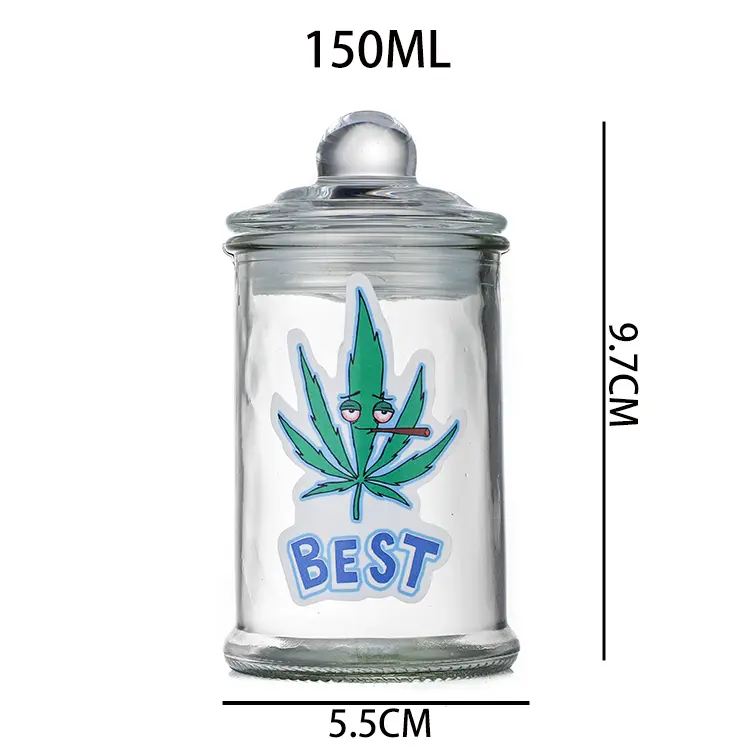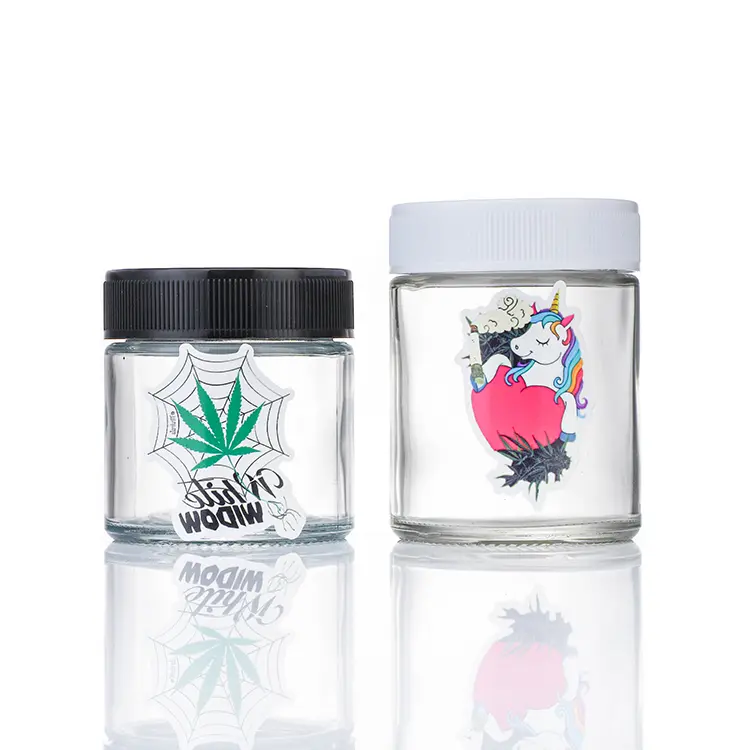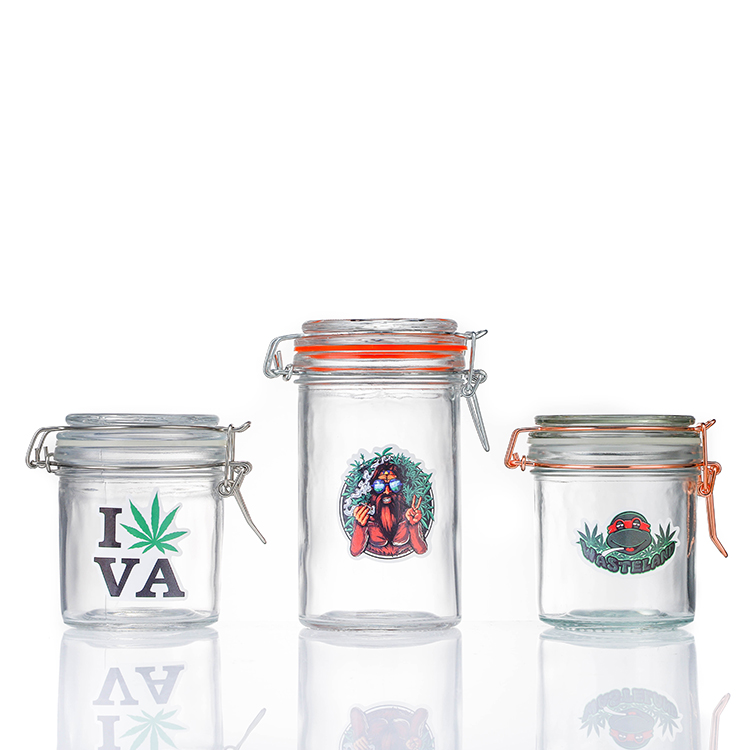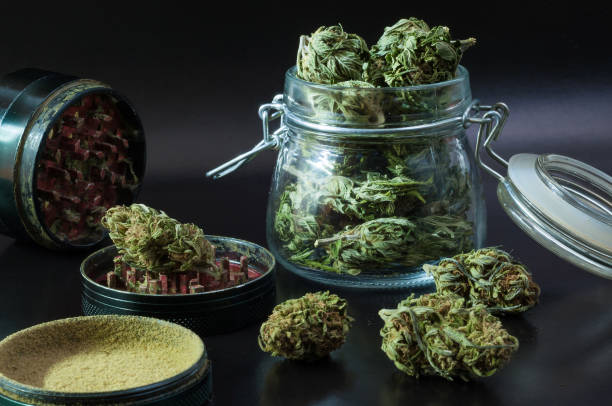Your Ultimate Guide to Recycling and Repurposing Cannabis Jars & Containers
06-09-2025
The cannabis industry is booming, bringing incredible new products to the market. But with this growth comes a growing problem: packaging waste. From small glass jars to plastic tubes and mylar bags, the amount of waste can be staggering. As a business owner or a consumer, you might be wondering how you can make a difference. How can you properly dispose of, recycle, or even repurpose these containers?
As someone who has been in the glass packaging industry for over a decade, my name is Allen, and my company, Glint, operates seven production lines in China, supplying high-quality glass packaging to major markets in the USA, Europe, and Australia. I've worked closely with business owners like Mark Thompson, a procurement officer in the US who values quality and sustainability. I understand the challenges and the opportunities within cannabis packaging. This article is here to guide you. We'll break down the complexities of cannabis recycling, provide clear, step-by-step instructions, and offer creative ways to give your old containers a new life. This is your comprehensive resource for making more sustainable choices in the world of cannabis.
Why Is Recycling Cannabis Packaging So Complicated?
You might think recycling your cannabis container is as simple as tossing it in the blue bin. Unfortunately, it's often not that easy. The path from your hands to a recycling facility is filled with unique obstacles specific to the cannabis industry. First, many products come in complex, multi-material packaging. A single jar might have a glass base, a plastic lid, a foam liner, and an adhesive label. Recycling facilities are designed to process single materials, and these mixed-material items can contaminate an entire batch, forcing it to be sent to a landfill.
Another major hurdle is the residue left inside. Even a tiny amount of cannabis residue can classify the container as paraphernalia or even hazardous waste in some regions. Because cannabis is still federally illegal in the United States, many municipal recycling programs are hesitant to accept any packaging associated with it, fearing legal complications. This creates a confusing landscape where rules vary drastically from one city to another, leaving both consumers and businesses unsure of how to properly dispose of their cannabis packaging.
Furthermore, state regulations designed to keep cannabis products safe and child-resistant often require excess packaging. These robust safety features, while necessary, contribute to the overall amount of waste. A small amount of product might be housed in a large, bulky container to meet legal standards. This combination of material complexity, legal gray areas, and regulatory requirements makes cannabis recycling a significant challenge that the industry is actively working to solve.
What Are the Different Types of Cannabis Containers?
Navigating the world of cannabis packaging means encountering a wide array of materials. Understanding these materials is the first step toward responsible disposal. Each type has its own pros and cons when it comes to both functionality and recyclability. For businesses, choosing the right packaging is a crucial decision that impacts product integrity, brand perception, and environmental responsibility.
Here’s a breakdown of the most common types of containers you'll find at a dispensary:
| Container Type | Material | Recyclability | Common Uses |
|---|---|---|---|
| Jars | Glass | Highly recyclable, infinitely reusable. | Flower, edibles, concentrates. |
| Plastic Containers | Plastic (#1, #2, #5) | Varies by type and local facility. | Flower, pre-rolls, edibles. |
| Mylar Bags | Multi-layer plastic & aluminum | Generally not recyclable curbside. | Flower, edibles, single-use products. |
| Tubes (Doob Tubes) | Plastic or Glass | Plastic tubes are sometimes recyclable. | Pre-rolls. |
| Vape Cartridges | Metal, Glass, Plastic, Battery | Requires special handling; not curbside. | Vape pens, CBD oil. |
From my perspective as a manufacturer, high-quality marijuana glass jars are the superior choice for sustainability. Glass is one of the few materials that can be recycled endlessly without any loss in quality. It’s also inert, meaning it won’t leach any chemicals into the cannabis product, preserving its purity and flavor. While plastic containers can sometimes be recycled, they often have a limited recycling life and contribute to the global plastic waste problem. Mylar bags are the most problematic, as their layered construction makes them nearly impossible for standard recycling facilities to process.

How Do I Prepare Used Cannabis Jars for Recycling?
Proper preparation is the most critical step to ensure your used cannabis jars actually get recycled. A contaminated container can ruin an entire batch of recyclables, diverting it straight to the landfill. Taking a few extra minutes to clean your jar makes all the difference. Think of it this way: you wouldn't toss a half-full peanut butter jar in the recycling bin, and the same principle applies here.
Follow these simple steps to prepare your glass and plastic weed containers for the recycling bin:
- Empty It Completely: Scrape out any and all remaining cannabis product. Make sure the container is as empty as you can get it.
- Clean Out the Residue: This is crucial. For sticky concentrates or resin, start by soaking the jar in isopropyl alcohol. A good shake should dislodge most of the residue. For flower jars, a simple wash with hot, soapy water is usually enough. Use a small brush or cotton swab to scrub away any stubborn spots.
- Rinse and Dry: After cleaning, rinse the container thoroughly with water to remove any soap or alcohol. Let it air dry completely. Wet items can cause issues at the recycling facility.
- Separate the Parts: If your jar has a separate lid, label, or liner, remove them. Plastic lids may have a different recycling number than the jar itself. Paper labels should be removed if possible. Unfortunately, foam or plastic liners inside caps usually cannot be recycled and should be thrown in the trash.
By following these steps, you significantly increase the chances that your container will successfully make it through the recycling process. For businesses, providing these instructions to your customers can empower them to participate in your brand's sustainability efforts and reduce the environmental impact of your products.
Can You Actually Recycle Cannabis Containers?
The short answer is: yes, but it depends. The ability to recycle a cannabis container hinges on two key factors: the material it's made of and the rules of your local recycling program. Not all plastics are created equal, and not all cities have the infrastructure to process every type of material. This is why it's so important to become a recycling detective and understand what's accepted in your area.
For plastic containers, the key is the small number inside the chasing arrows symbol, known as the recycling number. Most curbside programs accept #1 (PETE) and #2 (HDPE) plastics, which are commonly used for water bottles and milk jugs. Some programs also accept #5 (PP) plastic, a durable material often used for sturdy cannabis jars. However, plastics like #3 (PVC), #4 (LDPE), #6 (PS), and #7 (Other) are rarely accepted in standard recycling bins. Always check your local municipality's website to confirm which numbers they process.
Glass, on the other hand, is a recycling champion. Most municipal programs readily accept clear, brown, and green glass jars. As a manufacturer, we advocate for glass because its recycling process is far more streamlined and efficient than plastic. A glass jar can be melted down and reformed into a new durable, high borosilicate cannabis jar with no degradation in quality. This creates a truly circular economy, reducing the need for virgin materials and saving a significant amount of energy. The challenge with cannabis is not the material itself but ensuring it's clean and accepted by the program.

Where Can I Recycle Used Cannabis Jars and Vape Pens?
Once your container is clean and ready, you need to find the right place to take it. Your options for recycling used cannabis jars and other packaging can vary, so exploring a few avenues is your best bet.
- Curbside Recycling Bin: This is the most convenient option for accepted materials like clean glass jars and #1, #2, or #5 plastic containers. Double-check your local guidelines first. If your container meets the criteria, you can simply place it in your recycling bin at home.
- Local Recycling Center: If curbside isn't an option, or if you have materials they don't accept at the curb, your local recycling center or transfer station is the next best place. They often have designated bins for different types of glass and plastic, increasing the likelihood of proper processing.
- Dispensary Take-Back Programs: A growing number of eco-conscious dispensaries and brands are launching their own recycling programs. They collect used containers from customers and partner with specialized recycling companies to handle them correctly. Ask your local marijuana dispensary if they offer a take-back or recycling program.
- Specialized Mail-In Programs: For hard-to-recycle items, companies like TerraCycle offer mail-in solutions. You can purchase a "Zero Waste Box" specifically for cannabis packaging, fill it up, and mail it back for proper recycling. This is an excellent option for businesses looking to offer a comprehensive recycling solution to their customers.
- Vape Pens and Batteries: This is where it gets tricky. Never throw vape pens or any device with a battery in the trash or your regular recycling bin. The lithium-ion batteries are a major fire hazard at recycling facilities. These items are considered e-waste. Look for a local hazardous materials management facility or e-waste collection events in your community. Some electronics stores also have battery drop-off bins.
What Parts of Cannabis Packaging Cannot Be Recycled?
It's just as important to know what cannot be recycled as what can. Tossing the wrong items into your recycling bin can lead to "wish-cycling," where your good intentions end up causing more harm than good by contaminating the recycling stream. Awareness is key to an effective recycling effort.
Here are some common components of cannabis packaging that typically cannot be recycled through standard programs:
- Mylar Bags: These multi-layered bags, often used for flower and edibles, are a composite of plastic and aluminum. This mixture makes them impossible for most recycling facilities to separate and process. They belong in the trash.
- Black Plastic: Many recycling facilities use optical scanners to sort plastics. Black plastic doesn't reflect light, making it invisible to these scanners. As a result, even if it's a recyclable type like #5 plastic, it often ends up in the landfill.
- Small Lids and Caps: Items smaller than 2 inches in diameter often fall through the sorting machinery at recycling facilities. Unless your local program specifically says to re-attach them to the container, these small caps should be thrown away.
- Foam or Silicone Liners: The small liners inside the lids of many jars are not recyclable. They need to be removed and discarded.
- Adhesive Labels: While most facilities can handle paper labels, thick plastic or shrink-wrap labels should be removed before you recycle the container.
- Disposable Vape Pens: As mentioned, the combination of plastic, metal, and an integrated battery makes disposable vape pens a complex item that requires special e-waste recycling.
The prevalence of non-recyclable materials highlights the importance of choosing sustainable packaging solutions from the start. As a business, opting for simple, single-material packaging, like a clear glass jar with a simple metal lid, makes the recycling process much more straightforward for your customers.

How Can Businesses Promote the Reuse and Recycling of Cannabis Jars?
For businesses in the cannabis industry, sustainability is no longer a niche concern; it's a core part of brand identity. Your customers, especially younger demographics, care about the environmental impact of their purchases. Promoting the reuse and recycling of your cannabis jars is a powerful way to connect with your audience and demonstrate corporate responsibility.
First, the process begins with the packaging you choose. As a procurement officer like Mark Thompson would know, the initial sourcing decision has ripple effects. Opt for packaging that is easily recyclable. Child-resistant glass jars are an excellent choice because glass has high recycling rates and is favored by consumers. Work with suppliers who can provide clear information on material composition and recyclability. At Glint, we prioritize this transparency, ensuring our clients know exactly what they're getting.
Second, education is key. Use your packaging and marketing channels to inform your customers.
- Add Clear Labeling: Print a small, clear message on your label like "Please Clean and Recycle This Jar" or include the specific plastic recycling number.
- Create Website Content: Have a dedicated page on your website explaining how to recycle or repurpose your packaging.
- In-Store Signage: If you have a physical dispensary, use signage to promote your commitment to sustainability and guide customers on recycling.
- Incentivize Returns: Consider offering a small discount or loyalty points to customers who bring back their clean, empty containers. This not only encourages recycling but also drives repeat business.
What Are Some Creative Ways to Repurpose Old Weed Containers?
Before you even think about the recycling bin, consider this: the most eco-friendly option is to reuse. Repurposing your old containers extends their life, saves resources, and can be a fun, creative project. High-quality glass jars are particularly perfect for a second life due to their durability and aesthetic appeal.
Here are some fantastic ways to repurpose your old weed containers at home:
- Spice & Herb Storage: Small glass cannabis jars are the perfect size for organizing your kitchen spices. Clean them thoroughly, and they become stylish, airtight containers for everything from oregano to chili powder.
- DIY Craft Organizer: Keep your small craft supplies tidy. Use jars to store beads, buttons, glitter, screws, or any other tiny items that tend to get lost.
- Travel-Sized Toiletry Holder: A clean, empty jar is great for holding small amounts of lotion, cream, or hair gel when you're on the go. It's a perfect way to avoid buying single-use travel-sized products.
- Miniature Planter: Small jars are ideal for propagating succulents or starting seeds. Just add a layer of small pebbles for drainage, some soil, and your plant cutting. They make for a beautiful, tiny windowsill garden.
- Homemade Candle Holder: Pour your own small candles into the jars. A repurposed cannabis jar can become a beautiful, scented candle for your desk or bathroom. You can even use them as simple votive holders.
- Create a "Stash" Jar for Other Things: Use it to store small, important items like guitar picks, paper clips, spare keys, or loose change.
The possibilities are endless. By finding new ways to use your old containers, you reduce the demand for new products and keep perfectly good materials out of the landfill. For businesses, promoting these ideas can add another layer of value for your customers. You could even create a social media campaign encouraging users to share their creative repurposing projects.

As a Business Owner, What Should I Look for in Sustainable Cannabis Packaging?
As a business owner or procurement officer, your choices have a massive impact on the sustainability of the entire supply chain. When sourcing cannabis packaging, especially from overseas suppliers in countries like China, it's about more than just finding the lowest price. It’s about finding a partner who aligns with your values of quality, reliability, and environmental stewardship. This is a key concern for savvy buyers like Mark Thompson.
From my experience running a factory with seven production lines, I can tell you that quality control is paramount. You need packaging that not only looks good but is also compliant and durable. Look for suppliers who can provide certifications like FDA compliance or ISO standards. Don't be afraid to ask for proof and be wary of suppliers who are hesitant to provide it—this is a red flag for certificate fraud, a major pain point for importers. A reliable partner will have a transparent process for quality inspection and be able to answer your technical questions, even if your expertise is in sales.
Communication and logistics are just as critical. Inefficient communication and shipment delays can kill a product launch. You need a supplier with a responsive, English-speaking sales team that understands your needs. Discuss logistics upfront. A good supplier can help you navigate shipping, customs, and delivery, ensuring your products arrive on time. Ultimately, the best sustainable packaging is a high-quality product from a trustworthy partner. A well-made glass food jar is not just recyclable; it's also highly reusable, giving your customers more value and reducing the overall environmental footprint.
What is the Future of Eco-Friendly Cannabis Packaging?
The cannabis industry is still young, and as it matures, so will its approach to packaging. The future is bright and focused on innovation and a circular economy. We're moving beyond just recycling and looking at a whole ecosystem of sustainable cannabis packaging solutions that reduce waste from the very beginning.
One of the most exciting trends is the rise of bioplastics and compostable materials. Companies are developing packaging from hemp, corn starch, and other plant-based materials that can break down naturally under the right conditions. This could be a game-changer for single-use items, diverting a huge amount of waste from landfills. Another key area is the development of refillable and reusable systems. Imagine customers bringing their own containers to a dispensary to be refilled, similar to a bulk food store. This model drastically reduces the need for new packaging altogether.
Industry-wide collaboration will also be crucial. We can expect to see more standardized recycling programs specifically for cannabis packaging, created through partnerships between brands, dispensaries, and waste management companies. As regulations evolve, there may be a push for less excess packaging, allowing for more streamlined, minimalist designs that are both safe and sustainable. The journey towards a truly green cannabis industry has just begun, and it's a collective effort that involves manufacturers like myself, brand owners, and conscious consumers all working together.
Key Takeaways to Remember
- Cleanliness is Crucial: Always empty and thoroughly clean your cannabis containers before attempting to recycle them. Residue is the #1 reason they get rejected.
- Know Your Materials: Glass and #1, #2, & #5 plastics are the most commonly recycled materials. Mylar bags and black plastics are generally not recyclable curbside.
- Check Locally: Recycling rules vary by location. Always check your local municipality's website to see what they accept in your recycling bin.
- Reuse and Repurpose First: The most sustainable option is to give your old containers a new life as storage jars, planters, or craft organizers.
- Dispose of Vapes Safely: Never put vape pens or batteries in the trash or recycling. Take them to an e-waste or hazardous waste facility.
- Businesses Drive Change: As a business, you can make a huge impact by choosing easily recyclable packaging, educating your customers, and working with reliable, transparent suppliers.








